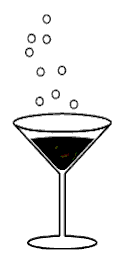 |
In the bubble sort, as elements are
sorted they gradually
"bubble" (or rise) to their proper location in the array, like bubbles rising in a glass of soda.
The bubble sort
repeatedly compares adjacent elements of an
array. The first and second elements are compared and swapped if
out of order. Then the second and third elements are compared and
swapped if out of order. This sorting
process continues until the last two elements of the array are compared
and swapped if out of order.
|
|
When this first pass through the array is complete, the
bubble sort returns to elements one and two and starts the process
all over again. So, when does it stop?
The bubble sort knows that it is finished when
it examines the entire array and no "swaps" are needed (thus
the list is in proper order). The bubble sort keeps
track of occurring swaps by the use of a flag.
The table below follows an array of numbers before, during, and after a bubble sort for
descending order. A "pass" is defined as one full trip
through the array comparing and if necessary, swapping, adjacent
elements. Several passes have to be made through the array before it is finally sorted.
|
| Array at beginning: |
84 |
69 |
76 |
86 |
94 |
91 |
| After Pass #1: |
84 |
76 |
86 |
94 |
91 |
69 |
| After Pass #2: |
84 |
86 |
94 |
91 |
76 |
69 |
| After Pass #3: |
86 |
94 |
91 |
84 |
76 |
69 |
| After Pass #4: |
94 |
91 |
86 |
84 |
76 |
69 |
| After Pass #5 (done): |
94 |
91 |
86 |
84 |
76 |
69 |
The bubble sort is an easy algorithm to program, but it is slower
than many other sorts. With a bubble sort, it is always necessary
to make one final "pass" through the array to check to see that no swaps are
made to ensure that the process is finished. In actuality, the process
is finished before this last pass is made.
// Bubble Sort Function for Descending Order
void BubbleSort(apvector <int> &num)
{
int i, j, flag = 1;
// set flag to 1 to start first pass
int temp;
// holding variable
int numLength = num.length( );
for(i = 1; (i <= numLength) && flag; i++)
{
flag = 0;
for (j=0; j < (numLength -1); j++)
{
if (num[j+1] > num[j])
// ascending order simply changes to <
{
temp = num[j];
// swap elements
num[j] = num[j+1];
num[j+1] = temp;
flag = 1;
// indicates that a swap occurred.
}
}
}
return;
//arrays are passed to functions by address;
nothing is returned
}
|